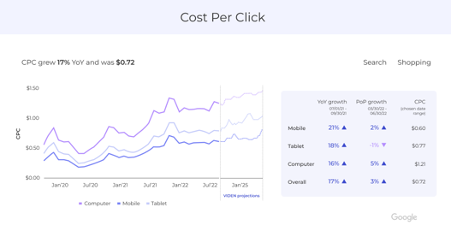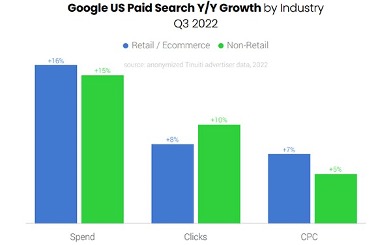If in 2020 you were paying an average of around 2 PLN per click, that figure may now exceed 3 PLN. This translates into up to 35% less traffic to your website — with the same budget!
The pandemic accelerated online shopping, forcing many businesses that previously relied heavily on offline sales to shift their operations online. This increase in traffic initially caused a decrease in the average CPC (cost per click).
Now, the situation has seemingly stabilized — the number of user queries is no longer growing as dynamically, but the number of new businesses entering the online space hasn’t slowed down. This creates an environment where companies find it increasingly difficult to compete for the same user.
As a result, the average CPC is trending upwards, and by 2023, we observed an increase of up to 30% (this percentage varies by industry). Additionally, there has been a significant shift toward more automated optimization strategies, which has also contributed to rising click costs.

Year after year, I see more brands increasing their marketing budgets to gain visibility, compete for users, and ultimately outpace their competitors. The market is further challenged by new entrants — companies with similar business profiles seeking to capture the same customers.
The average increase in spending starts at 10% and can go as high as 100%, depending on the competitiveness of the industry.
Building a strong brand based on core values is one way to navigate this environment. However, it must be a strategically made decision rather than left to chance. Failing to respond to these shifts not only reduces your share in ad impressions but also causes your brand to get lost in the sea of options your users are exposed to.

Your users are increasingly experiencing “banner blindness,” meaning they pay less attention to the ads you present to them.
Every day, we are exposed to hundreds, if not thousands, of pieces of information while browsing content that we find valuable. This negatively impacts the retention of advertising messages. To maintain a similar level of awareness, we now need to continuously increase the number of impressions per unique user in order to effectively reach them.
Last year, the number of impressions per unique user rose to over 70 — meaning you need to show your ad that many times for the message to stick. This results in a 3-7% annual increase in marketing budgets for display ads.
Ensuring high ad quality is the foundation of effective marketing efforts. Pay close attention to tailoring your ads to your target audience and the stage of the customer journey where they encounter them. The quality of the materials (resolution, aesthetics, and content alignment) is also critical. This will help you reach your target group more effectively and achieve better marketing metrics (e.g., lower cost per click, conversion rates, and lead generation). In turn, this optimizes your budget and provides a competitive advantage.
Nothing harms your metrics more than spending budget on ads shown in places where no one is interested in viewing them. Protecting your marketing budget by excluding low-performance areas is essential. Whether you exclude based on geographic or demographic factors or even specific websites, don’t rely entirely on automation — algorithms will always aim to maximize the priorities you set, but verifying and adjusting based on performance is crucial.
Data analysis and insights are the foundation of effective campaigns. Without data, you cannot make informed business decisions or properly optimize algorithms. In the current cookieless era, this aspect has become even more critical. Ensure you have the tools and solutions in place to collect data. Pay special attention to tools such as Google Consent Mode, offline/CRM data imports, Server-Side Tagging, and Enhanced Conversions.
Don’t rely solely on Google. For e-commerce stores, one interesting solution is using external CSS (Comparison Shopping Services), which are product feed comparison engines outside of Google’s system.
This solution allows you to keep your standard product campaigns unchanged while saving on CPC. Shifting your product feed to platforms outside of Google can lead to savings, with average CPC reductions of up to 25%.
Don’t fall behind! It’s essential not to overlook the changes happening in the advertising market.
Google Ads costs are continuously rising, which poses a challenge for marketers. The average cost per click (CPC) increased by up to 30% by 2023, making it harder to reach users effectively with the same budget.
Competitor spending is rising, and new players are entering the advertising market, intensifying the competition for user attention. Brands must increase their ad budgets to stay visible and compete effectively.
Banner blindness is causing users to ignore ads more frequently. Increasing the frequency of ad impressions is necessary, leading to a 3-7% annual rise in display ad costs.
Effective marketing requires attention to ad quality and campaign optimization. Aligning content with your target audience and their position in the customer journey, while excluding ineffective targeting, is crucial for success.
Data analysis is key to making informed business decisions. With changing data privacy regulations, using tools like Google Consent Mode and offline data imports is essential for effective ad personalization.
Exploring solutions beyond Google Ads, such as external CSS for e-commerce stores, can save up to 25% on CPC while maintaining the efficiency of product campaigns.

O AUTORZE
Bij Yetiz leidt hij het team dat verantwoordelijk is voor het voeren van campagnes op Google en Facebook Ads. Dagelijks richt hij zich ook op het maken van marketingplannen en het beheren van betaalde campagnes voor onze grootste klanten. In zijn vrije tijd houdt hij ervan actief te zijn, wat hem helpt om een psychologische en fysieke balans te behouden tussen het dagelijkse werk aan het bureau.
© 2024 YETIZ INTERACTIVE Created with ♡ by Yetiz
PRIVACY BELEID